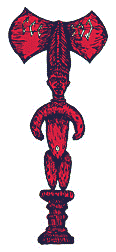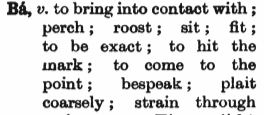
Oba Koso
The King Does Not Hang
Oba Koso
Shango
The God King Sango
Oba Koso in the chronology
Obatala & Shango
Oba Koso & the end of Ile Ife
Alternate etymology for Oba Koso

Oba Koso was the last major production of the Arthur Hall Afro-American Dance Ensemble in Philadelphia. The classic Nigerian folk opera is over 500 years old and was adapted to the stage by Duro Ladipo of Nigeria in 1963. Since that time it has been well received throughout Nigeria, Europe, South America and the Caribbean. It toured the US in 1974, still in its original Yoruba language. Arthur Hall's 1987 production in Philadelphia was the play's English language premiere.Oba Koso combines spirited drumming, drama, dance and music in the rich imagery of the Yoruba culture. It is story of an ambitious king trying to pacify two warlike generals. There are duels, tragic encounters, and ultimately the spiritual veneration of the king Shango.
The Philadelphia production of Oba Koso performed by the Arthur Hall Afro-American Dance Ensemble featured Eegunbunmi Isiaka, a performer in the 1974 Oba Koso tour (when Mr. Isiaka was only 11 years old). He received critical acclaim for his mastery of the various West African drums, and has been featured in many Nigerian television programs, radio dramas and stage shows. He has worked with many notable Nigerian dramatists, including Nobel laureate Wole Soyinka, Joel Adedeji, Folabo Ajayi, and Ademola Onibonokuta.
Artistic director Arthur Hall was assisted by Mrs. Adiodum Duro Ladipo, the wife of the late playwrite. Oba Koso has been likened to Macbeth, both as a tragedy and for the many superstitions which surround it.
The last chairperson of the Ile Ife Center, Robert J. Rutman, Ph.D., writes,
During this period Arthur undertook the Herculean task of adapting and presenting an African folk drama. His approach was unique and demanding in many ways. Arthur decided on the drama Oba Koso, a Yoruba folk myth. To guarantee authenticity, Arthur invited the wife of the playwrite Duro Ladipo to come to the USA from Nigeria to advise on the production. The dialogue would be in English, but the libretto would be sung in Yoruba, requiring the entire cast to learn the language involved. This is a first.A number of the Nigerian Embassy staff attended the opening performance and were so favorably impressed that they brought the Ambassador to the final performance, during which the Embassy people danced in the aisles ...
Robert J. Rutman, 3/9/96
Shango is an historical Yoruba king who through the story of Oba Koso ("The King does not hang") has joined the ancestors, and in the new world has become one of the seven principal Orishas. In the Afro-Cuban Santeria, Shango is recognized as the god of lightning, thunder, drums, dancing, and yams. Because he shares lightning and fire with Oya, the godess of the whirlwind (and winds in general and "the gates of the cemetery"), Oya traditionally is said to be Shango's favorite wife, both warriors who, in the New World at least, ride to war together.In Cuba and in Brazil, however, it is sometimes thought that Oya is also the wife of Ogun (the machete wielding blacksmith Vulcan), which offends traditional "monarchist" Yoruba insofar as among her other attributes Oya is also the principle of steadfast devotion and loyalty. There is a passage in Orisun Omi in which the young narrator states flatly that "Oya is the wife of Ogun," which does not play well in Ile Ife. On the other hand, Shango is said to have an eye for Oshun (Aphrodite, Venus), so perhaps, devotion or not, the New World Voodoo is simply acknowledging that what's good for the goose is good for the gander.

In Yoruba myth, Sango once ruled as the fourth Alafin of Oyo. After his extraordinary life and controversial death, his friends revered him as a god. His cult has enjoyed the royal patronage of the Alafin of Oyo, who is regarded as his descendant. Sango's cult played an important role in securing the people's loyalty to the Alafin in the days of the Oyo Empire.Sango's devotees regard him as the embodiment of great creative potential, unfortunately one that was tragically and unpredictably tempted to exceed its own limits and thereby destroyed what it had created. This dedication to the power over life and death and to creativity is reflected in Sango's shrines ...
Small images of twins (ere Ibeji) are also often stored in the shrine, as legend states that Sango was himself a twin.
Sango's symbol, the twin-stone ax, or oshe Sango, is believed to be energized with protective powers. It is used as a badge of membership in the cult. Sango is a god who possesses his devotees by entering their heads. When a priestess has been seized by the spirit of the god, she will dance with the wand in her left hand. A twin-stone ax rises out of the top of the wand's carved head, symbolizing this dramatic change and representing priest and deity simultaneously. As she moves, a chorus of women call out the praises of Sango, and an orchestra of drummers beat out sharp, erratic, staccato rhythms on their Bata drums. Suddenly, the priestess will wave her wand fiercely, threatening the audience, mimicing with her movements lightning lashing from storm clouds and then quietly receding ...
Michael Conner

The Board of Directors [of Ile Ife c. 1986] under Chuck Powell presented a reorganization plan under which Arthur would reliquish the directorship of Ile Ife and the business of the Arthur Hall Afro-American Dance Ensemble. Arthur, backed by five board members, refused to resign, and the board split 7 to 5 against Arthur. This forced the resignation of the majority of the board. A new board was [formed with Bob Rutman as chair].Dr. Rutman then describes Oba Koso as a "Herculean task." He continues:During this period, Ile Ife was pressed strongly to move out of Germantown Avenue and on to new developments on Broad Street near the Uptown Theatre, part of the strategy being developed by Powell, John Allen and others to concentrate minority arts along North Broad. Arthur's position was that Ile Ife served a community in North Philadelphia, and this would be lost under the new proposals. Extensive efforts were made toward a counter proposal for an African Arts community around Ile Ife.
Under the leadership of Ile Ife, [Bob Rutman] and the director of the Afro-American Historical and Cultural Museum, Rowena Stewart, a Minority Cultural Alliance was established. Leadership was quickly and arbitrarily seized by John Allen and the Freedom Theatre management, and Ile Ife was effectively cut out of the action.
Although Oba Koso was a great artistic accomplishment and a wonderful cultural contribution, it received no real support from the Minority Cultural Community or the Cultural Alliance nor from the City of Philadelphia. ... Oba Koso was a truely remarkable achievement and should be given appropriate prominence.Alternate etymology for Oba Koso
Hi. My name is Omofarafina and I'm an African language diviner and researcher who just came across your website while researching the original name of Yoruba thunder god, Obakoso [Ọbakọsọ].
It states on your website that "Obakoso" means "the king does not hang": http://ileife.org/oba/obakoso.html
While it does seem to mean that based on Oba [Ọba] meaning "king" and "so" meaning to "hang, suspend" in Yoruba, this is not the correct breakdown of the name of the ancient thunder god.
His name is properly written as Obakoso [Ọbakọsọ], and it is broken down as O-ba-ko-so [Ọ-ba-kọ-sọ] (Aw-Bah-Kaw-Saw, not Oh-Ba-Ko-So), which means "he (O [Ọ]) sits (ba) on the thrown flashes of light (ko so [kọ sọ])", basically, he sits on the flashes of lightning which are thrown. It could also mean "the king (Oba [Ọba]) who throws flashes of light (ko so [kọ sọ])".
This is the source of the name of the original lightning god, and perfectly describes his Zeus-like characteristic of being associated with thrown lightning bolts.
I have attached screenshots from a Yoruba pdf dictionary for more adequate referencing for you.
Hope this has been helpful. Thanks for what you do. Peace. 



